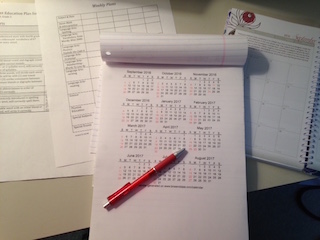7 more tips to planning your homeschool, and a gift

By Kathy Kuhl

Last time, I gave you the first four steps to writing a plan for homeschooling children who learn differently. You can find that post here, but here’s a summary:
-
- Plans need to be flexible. Plan in pencil or on a computer, not in ink.
- Begin by looking at holidays and family activities on a 12 month calendar.
- Choose the dates you plan to homeschool, considering the homeschool law in your state or province, your family’s needs (for example, siblings coming back from college,business, deployment, surgery).
- As you plan when you will teach, expect that you may accomplish less when you teach around the holidays and other extraordinary times.
(Click here for your goal-setting guide! Free when you sign up for my newsletter.)
Finish your plan with these 7 steps
- Imagine how you would like a typical week to go. Before you plan your weeks in detail, think of the flow of a good week. Plan your most important activities first. For most of our kids, that’s language arts and mathematics. For some children, therapy is our top priority, for others, learning to read.
Choose the best time of day for what’s most important. If your child starts slowly, as mine did, start your day gently. We read the Bible first and prayed, then started literature on the sofa together. Even in high school, reading Twelve Angry Men aloud together was more fun in a relaxed setting. Math was also a struggle for my son, so I scheduled math every morning, after our morning exercise break. Sometimes math came with a snack.
Exercise is also vital. Pencil it time for it at least once daily. Some kids—and adults—need several short breaks during the day. Some need breaks to move several times every hour!
Don’t forget to schedule what you need to keep yourself going. A support group? A daily walk around the block? A weekly solo trip to the grocery store? At some stages of raising children, that’s a big treat. - What about history, music, art, science, physical education and other subjects you may not cover daily? These are vital. But they don’t have to be daily. And they mustn’t be dull. Here’s some ways to vary your schedule for subjects you won’t have daily:
- We had history Wednesday afternoons 12-3, plus many field trips.
- We worked on science a couple afternoons a week, largely hands-on activities. For science, we enjoyed Dorling Kindersley–very motivating for my slow reader–and Janice Van Cleave books for elementary grade experiments and demonstrations.
- Art: we created art at home at least once a week, and learned some art history at co-op and in museums. We kept art supplies handy and good books like Quentin Blake’s Drawing: for the Artistically Undiscovered, and Thatcher Hurd’s Watercolor: for the Artistically Undiscovered, both from Klutz Press. I’m not artistic, so these relaxed, cheerful books appealed to me, and encouraged my son to experiment with techniques, strengthening his joy in creating.
- In the same way, music was an occasional pursuit, through recorder lessons at home, weekly music lessons in our co-op one year, and listening to and enjoying classical music on loud in car and home. We occasionally went to concerts and to instrument petting zoos before concerts.
- Drama and speech were also outside the house at a weekly club or class.
- Logic and critical thinking were subjects we covered as part of math or language arts. Some years they were a larger part of our homeschool because…
- You don’t need to cover all of these subjects every year!
- Divide your curriculum by your number of days. E.g. your math curriculum has 150 lessons, you want to homeschool 36 weeks, you need to finish 4 lessons a week for most weeks. But 4 x 36 = only 144, so you need to finish five lessons a week for six of those weeks.
(This is where your notes about less productive times is useful: the week of the child’s birthday or Grandma’s visit are not good times to get more work done. But if you decide the workload is impossible, then it’s time to: - Be realistic about how your will cover each subject.
Thoroughly preview the curriculum you’ve bought. Is this more than you can expect your child to finish in the weeks you’ve planned to teach? Look at the content, the scope and sequence, and decide what to cut. How do you decide what to cut?- Don’t cut something just because you didn’t study it in school,
- Don’t cut just because it sounds weird, like “box and whisker plots,”
- Do look at a standard or two, not to be ruled by them, but for ideas. For instance, I looked at my state standards. They had some goals I didn’t think worthwhile, and others I liked and wouldn’t have thought of. (In Homeschooling your Struggling Learner, I list some standards I have found helpful.)
- Decide if this course is a twelve-month project instead of a nine-month one.
- Check to see if your child has already mastered some of this material? Math books, for instance, often have a practice test at the end of each chapter, which can be given before the chapter to help you see if there are skills your child has already mastered and can skip. But I mean solidly mastered, not “mostly remembered.” We can adapt how much of the materials we will use.

My favorite tools: a 12 month calendar, goals, pad of paper, pencil & pen, planner - Plan your year, quarter, month, week. Plan the year broadly. For example, if teaching multiplication facts this year, beginning in August:
zeros and ones in September
twos and fives in October
fours in November
review in December with extra math games to maintain skills.
nines in January
sixes in February
eights in March
sevens in April - Review your plans every week. How’d it go? What took longer? Don’t feel dread and discouragement, just adapt and move on. You are doing what the schools cannot do nearly as easily: you are adjusting to the actual progress of your child.
What went faster than expected? Celebrate it. Don’t just fill in that whole in the schedule. Praise your child. Sometimes you might reward yourselves with something fun. - Put your plan on a paper by using or making a planner. Buy, download, or make one. When I started homeschooling, I bought a large, spiral-bound, lesson planner from a teaching supply store, because I wanted large squares. I liked having a two-page spread per week, with a row for each subject, and a column for each day: Monday-Wednesday on the left, Thursday, Friday and a column for notes on the right. Then I made my own in a similar format, but in a binder, so I could add pages. These days, as an empty nester, I use Well Planned Gal’s On the Go planners.
I love my electronic calendar on my phone and laptop. I can enter a weekly event once, instead of copying it over and over. That way, electronic calendars such as Google Calendar and iCal usually—but not always—keep me from agreeing to be three places at once.
In her blog Una Familia Alaskena, Debbie recommends creating a “bullet journal,” a handwritten, personalized planner in a Moleskine or other blank journal. http://unafamiliaalaskena.blogspot.com/2016/06/using-bullet-journal-in-your.html?m=1
While I never had time to draw, much less color, a year-at-a-glance, month-at-a-glance, and weekly schedules, I agree paper has advantages. My paper planner never runs out of power, can go anywhere, and makes me a little more thoughtful.
To cheaply make my own personal, customer planner, I could quickly make free calendars from timeanddate.com, print, punch holes, and put them into a binder.
What helps you plan? Please answer in the comments section below. You may also like Gabriella Volpe’s 9-part blog series on this topic.


